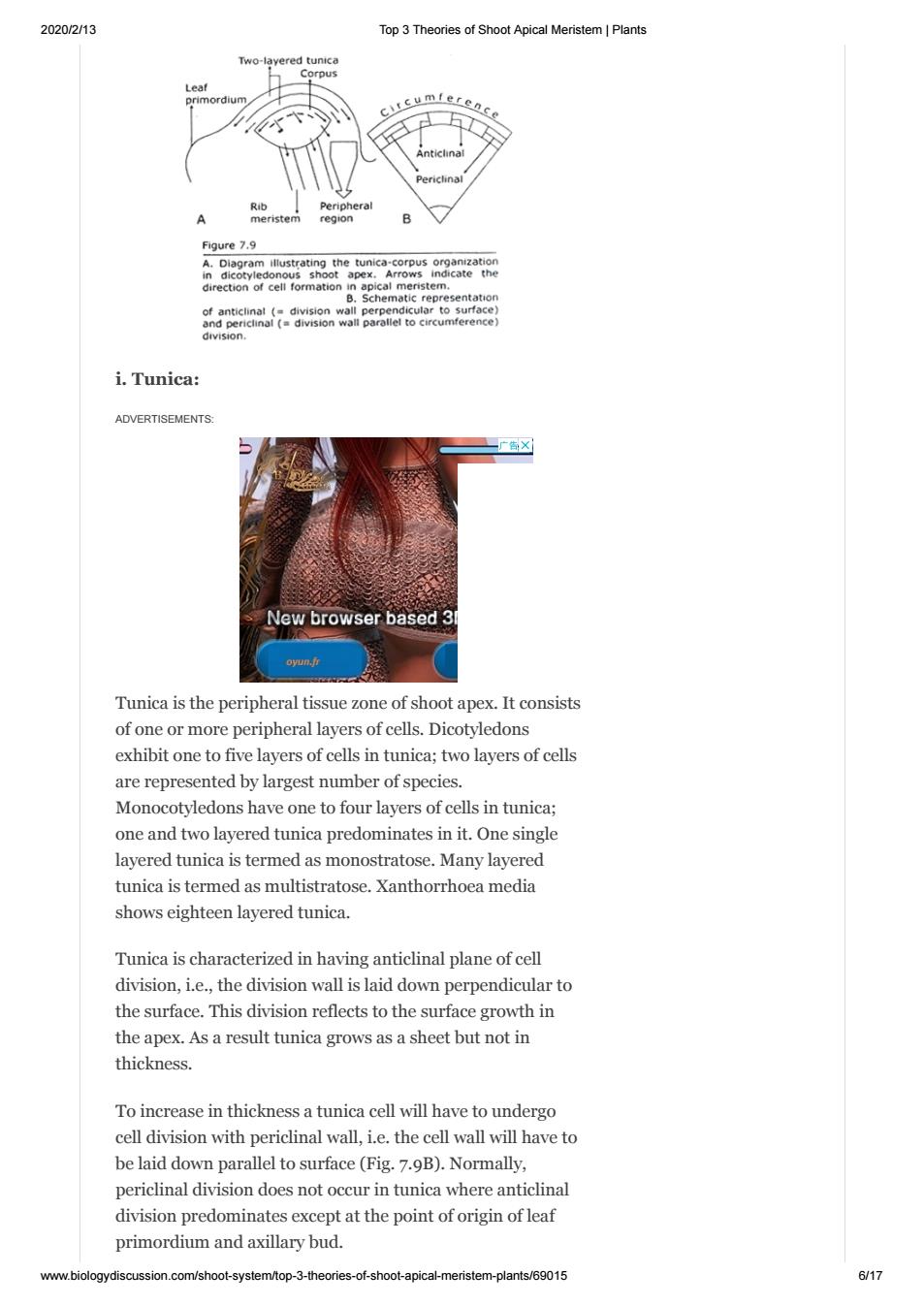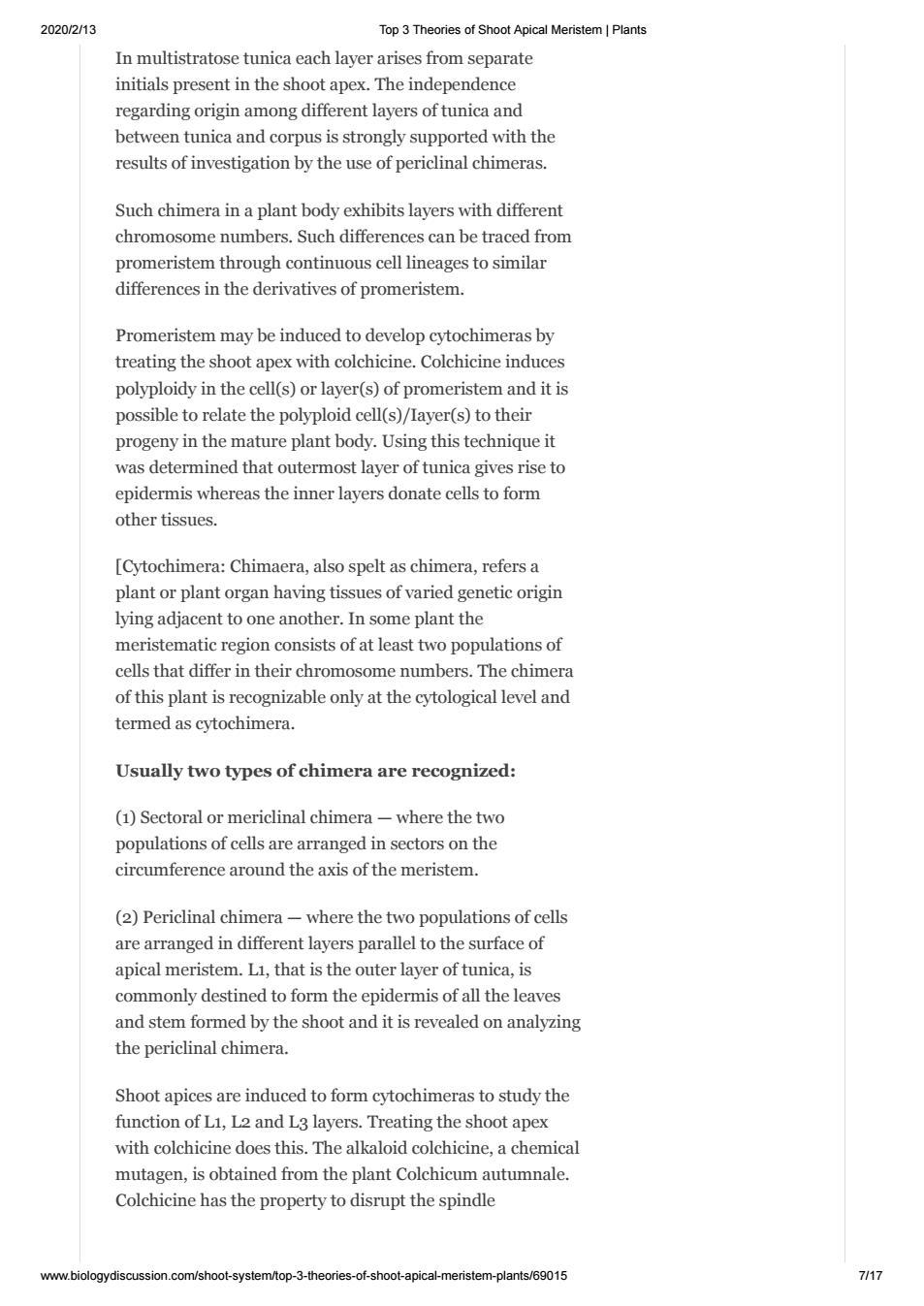
2020/2/13Top3Theories of Shoot Apical Meristem|PlantsTwo-layeredtuniceCorouLeafprimordiunticericinRibPeripheralBAmeristemregionFigure 7.9A.Diagram ilustrating thetunica-corpus organizationin dicotyledonous shoot apex.Arrows indicate thedirection of cell formation in apical meristemB.Schematicrepresentationof anticlinal (-division wall perpendicular to surface)andpericlinal (adivisionwallparalleltocircumference)division.i. Tunica:ADVERTISEMENTS:Newbrowserbased3UnTunica istheperipheral tissue zoneof shootapex.Itconsistsofone or more peripheral layers of cells.Dicotyledonsexhibitonetofivelayersofcellsintunica;twolayersofcellsare represented bylargest number of species.Monocotyledons have one to four layers of cells in tunica;one and two layered tunica predominates in it. One singlelayeredtunicaistermedasmonostratose.Manylayeredtunicaistermed asmultistratose.Xanthorrhoeamediashows eighteen layered tunica.Tunica is characterized in having anticlinal plane of celldivision, i.e., the division wall is laid down perpendicular tothe surface. This division reflects to the surface growth inthe apex. As a result tunica grows as a sheet but not inthickness.To increase in thickness a tunica cell will have to undergocell division with periclinal wall, i.e. the cell wall will have tobe laid down parallel to surface (Fig. 7.9B). Normally,periclinal division does not occur in tunica where anticlinaldivision predominates except at the point oforigin of leafprimordium and axillarybud.6/17www.biologydiscussion.com/shoot-system/top-3-theories-of-shoot-apical-meristem-plants/69015
2020/2/13 Top 3 Theories of Shoot Apical Meristem | Plants www.biologydiscussion.com/shoot-system/top-3-theories-of-shoot-apical-meristem-plants/69015 6/17 i. Tunica: ADVERTISEMENTS: Tunica is the peripheral tissue zone of shoot apex. It consists of one or more peripheral layers of cells. Dicotyledons exhibit one to five layers of cells in tunica; two layers of cells are represented by largest number of species. Monocotyledons have one to four layers of cells in tunica; one and two layered tunica predominates in it. One single layered tunica is termed as monostratose. Many layered tunica is termed as multistratose. Xanthorrhoea media shows eighteen layered tunica. Tunica is characterized in having anticlinal plane of cell division, i.e., the division wall is laid down perpendicular to the surface. This division reflects to the surface growth in the apex. As a result tunica grows as a sheet but not in thickness. To increase in thickness a tunica cell will have to undergo cell division with periclinal wall, i.e. the cell wall will have to be laid down parallel to surface (Fig. 7.9B). Normally, periclinal division does not occur in tunica where anticlinal division predominates except at the point of origin of leaf primordium and axillary bud

2020/2/13Top 3Theories of Shoot Apical Meristem|PlantsIn multistratose tunica eachlayer arisesfrom separateinitialspresentintheshootapex.Theindependenceregarding origin among different layers of tunica andbetween tunica and corpus is strongly supported withtheresults of investigation by the use of periclinal chimeras.Such chimera in aplantbody exhibitslayerswithdifferentchromosomenumbers.Suchdifferencescanbetracedfrompromeristem through continuous cell lineages to similardifferences in the derivatives of promeristem.Promeristem may be induced to develop cytochimeras bytreatingthe shootapexwith colchicine.Colchicineinducespolyploidy in the cell(s) or layer(s) of promeristem and it ispossible to relate the polyploid cell(s)/layer(s) to theirprogeny in the mature plant body. Using this technique itwas determined that outermost layer of tunica gives rise toepidermis whereas the inner layers donate cells to formothertissues.[Cytochimera: Chimaera, also spelt as chimera, refers aplant or plant organ having tissues of varied genetic originlyingadjacentto one another.In someplantthemeristematic region consists of at leasttwo populations ofcells that differ in their chromosome numbers.The chimeraof this plant is recognizable only at the cytological level andtermed as cytochimera.Usuallytwotypes of chimera are recognized:() Sectoral ormericlinal chimera-where thetwopopulations of cells arearranged in sectors on thecircumferencearoundthe axis ofthemeristem.(2) Periclinal chimera - where the two populations of cellsare arranged in different layers parallel to the surface ofapical meristem.Li,that is theouterlayer oftunica,iscommonlydestinedtoformtheepidermisofalltheleavesand stem formed by the shoot and it is revealed on analyzingthe periclinal chimera.Shoot apices are induced to form cytochimeras to study thefunction of Li, L2 and L3 layers. Treating the shoot apexwith colchicine does this.The alkaloid colchicine,a chemicalmutagen, is obtained from theplant Colchicumautumnale.Colchicine has the propertyto disruptthe spindle7/17www.biologydiscussion.com/shoot-system/top-3-theories-of-shoot-apical-meristem-plants/69015
2020/2/13 Top 3 Theories of Shoot Apical Meristem | Plants www.biologydiscussion.com/shoot-system/top-3-theories-of-shoot-apical-meristem-plants/69015 7/17 In multistratose tunica each layer arises from separate initials present in the shoot apex. The independence regarding origin among different layers of tunica and between tunica and corpus is strongly supported with the results of investigation by the use of periclinal chimeras. Such chimera in a plant body exhibits layers with different chromosome numbers. Such differences can be traced from promeristem through continuous cell lineages to similar differences in the derivatives of promeristem. Promeristem may be induced to develop cytochimeras by treating the shoot apex with colchicine. Colchicine induces polyploidy in the cell(s) or layer(s) of promeristem and it is possible to relate the polyploid cell(s)/Iayer(s) to their progeny in the mature plant body. Using this technique it was determined that outermost layer of tunica gives rise to epidermis whereas the inner layers donate cells to form other tissues. [Cytochimera: Chimaera, also spelt as chimera, refers a plant or plant organ having tissues of varied genetic origin lying adjacent to one another. In some plant the meristematic region consists of at least two populations of cells that differ in their chromosome numbers. The chimera of this plant is recognizable only at the cytological level and termed as cytochimera. Usually two types of chimera are recognized: (1) Sectoral or mericlinal chimera — where the two populations of cells are arranged in sectors on the circumference around the axis of the meristem. (2) Periclinal chimera — where the two populations of cells are arranged in different layers parallel to the surface of apical meristem. L1, that is the outer layer of tunica, is commonly destined to form the epidermis of all the leaves and stem formed by the shoot and it is revealed on analyzing the periclinal chimera. Shoot apices are induced to form cytochimeras to study the function of L1, L2 and L3 layers. Treating the shoot apex with colchicine does this. The alkaloid colchicine, a chemical mutagen, is obtained from the plant Colchicum autumnale. Colchicine has the property to disrupt the spindle